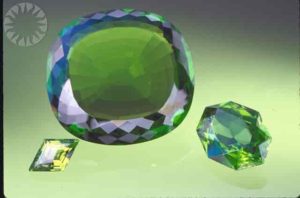
Peridot Stone the world’s largest cut ever found is 311.78 carats (62.35 grams)! It was found on Zagbargad Island, Egypt, and is now located in the Smithsonian Museums, USA. Also, in the Diamond Treasury – Moscow, Russia, an exquisite 192.75 carat Peridot gemstone is kept. In addition, a Peridot gem of 146 carat is housed at the Geological Museum in London, England.
With the endowment the Smithsonian has added to the original collection no less than 13,000 specimens, bringing the total to nearly 30,000. The Smithsonian labelled the original mineral specimens with R1 to R6000 catalog numbers. The remaining 10,000 specimens represented specimens of gemstones and meteorites, rather than raw minerals.
The world’s largest known peridot lies within this enormous collection. The Smithsonian catalogs it as NMHN G3398-00 (MIN), weighing in at 311.8 carats and cut in a mixed cushion shape.
The peridot originated from Zabargad Island (St. John’s Island), in Egypt, according to the record of the Smithsonian. They describe it as a primary gem with a slightly yellow dark green colouration. The Smithsonian lists his previous catalog number as R00008.
Can it be that the original 6,000 mineral specimens belonging to Washington A. Roebling belonged to this beautiful peridote?
Definitely, more work is needed to address the issue. So, I sent an email for this specimen to the new archivist. I’ll be returning and updating this article when I hear back.
Zabargad Island
Zabargad Island in Foul Bay, Egypt is the largest of a group of islands. It covers an area of 1.74 square miles (4.50 square kilometres). It is not a quaternary volcanic island but instead an upthrusted portion of upper mantle material is thought to be. The closest island is called Rocky Island. The island is slightly north of the Cancer Tropic and is 235 meters (771 feet) tallest.
The island is considered peculiar geologically because it is an uplifted mantle, a part of the lithosphere of the sub-Red Sea. The island’s rocks are mostly the lower metamorphic crustal rocks. After African and Asian continental plates converged to cause uplifting of rocks in the lower crust, the island was present above sea level. The island comprises three peridotite masses, which are rich in peridot gemstone (olivine). The island is believed to be the first source of peridot discovered, in ancient times called topazios, hence the Greek name for the island, Topazios. Spinel-lherzolite layers of anhydrous Al-diopside pyroxenites and hydrous Cr-diopside pyroxenites are also to be found on the island.
The island is part of the Elba National Park meaning the island is conserved. However, the island was closed to the public for one year due to damage to corals and the disturbance of birds who breed on the island.
When was Peridot first discovered?
Peridot is a Gemstone of antiquity. Peridot’s existence dates back over 3,500 years, when the Egyptians found the gemstone. Peridot was strongly desired and worshiped during those days. The gemstone has been said to have magical powers, and has also been used to heal and defend. The ancient Egyptians claimed the Peridot stone was capable of warding off evil and defending against nightmares.
Where is Peridot found?
Most Peridots occur in lava rocks, but the gemstone has been found in meteorites as well – in its basic form! The most common and precious Peridots are present in Burma and Pakistani. Most trading Peridots, however, come from the USA, China, Vietnam and South Africa.










